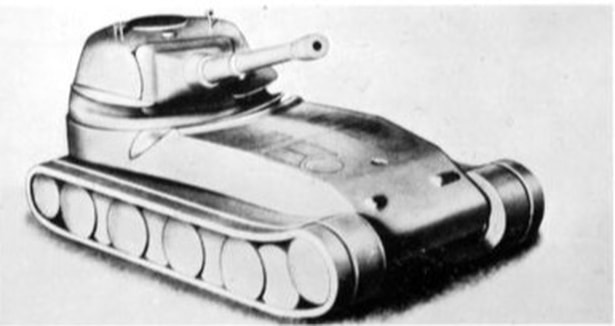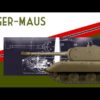The Maus, a heavy tank that was developed by Germany during World War II, is often associated with the engineering genius Ferdinand Porsche. However, the question of whether Porsche actually played a role in the creation of the Maus has been a subject of debate among historians and military enthusiasts for decades.
Some argue that Porsche was indeed involved in the development of the Maus. They point to his previous work on heavy tanks, such as the Tiger I and Tiger II, as evidence of his expertise in this area. Additionally, Porsche’s reputation as a skilled engineer and his close ties to the German military make it plausible that he would have been involved in such a significant project.
On the other hand, there are those who believe that Porsche’s involvement in the Maus project has been exaggerated. They argue that Porsche’s focus during the war was primarily on the development of armored vehicles for civilian use, such as the famous Volkswagen Beetle. Furthermore, some claim that Porsche’s design philosophy was not compatible with the requirements of a heavy tank like the Maus.
In order to fully unravel the history of the Maus and its connection to Porsche, it is important to examine the available evidence and testimonies from individuals involved in the project. Only by carefully analyzing these sources can we hope to determine the extent of Porsche’s involvement in the creation of this legendary tank.
Did Porsche Make the Maus?
The Maus is a legendary tank that was developed by the German army during World War II. This super-heavy tank was designed to be the ultimate weapon on the battlefield, with its massive size and thick armor.
While the Maus is often associated with Ferdinand Porsche, the renowned German automotive engineer, it is a common misconception that he was responsible for its design and production. In fact, Porsche’s involvement in the development of the Maus was limited.
The Maus was primarily designed by the engineer and tank designer, Dr. Ferdinand Porsche’s son, Ferdinand Porsche Jr., who was the chief designer at Porsche’s firm at the time. Porsche Jr. was responsible for the overall design and engineering of the tank, including its innovative features such as the electric transmission system and the suspension design.
However, due to various challenges and setbacks, the Maus never entered mass production. Only two prototypes of the tank were built, and both were captured by Allied forces at the end of the war. One of the prototypes is now on display at the Kubinka Tank Museum in Russia.
While Ferdinand Porsche Sr. did not directly contribute to the development of the Maus, his name is often associated with the tank due to his reputation as a prominent German engineer and founder of the Porsche company. It is important to clarify this misconception and give credit to the actual designers and engineers who were involved in the creation of the Maus.
Unraveling the History of this Legendary Tank
When it comes to legendary tanks, the Maus is often mentioned as one of the most iconic and intriguing designs. Built by Porsche during World War II, this super-heavy tank was intended to be the ultimate weapon, capable of overcoming any obstacle on the battlefield.
One of the most fascinating aspects of the Maus is its sheer size and weight. Weighing in at a staggering 188 tons, it was the heaviest tank ever built. With a length of over 33 feet and a height of nearly 12 feet, the Maus was an imposing presence on the battlefield.
Despite its impressive specifications, the Maus never saw combat. Only two prototypes were ever completed, and they never left the testing grounds. The reasons for this are still debated among historians. Some believe that the tank was simply too heavy and impractical for actual use, while others argue that it was a victim of changing priorities and resource shortages during the war.
Another interesting aspect of the Maus’s history is its connection to Porsche. While Porsche is primarily known for its sports cars today, during World War II, the company was involved in the development of various military vehicles, including tanks. The Maus was one of their most ambitious projects, showcasing their engineering prowess and innovative design ideas.
Today, the Maus is a symbol of German engineering excellence and a testament to the ingenuity of its creators. While it may not have seen combat, its legacy lives on as a reminder of the technological advancements and the arms race that defined World War II.
The Origin of the Maus
The Maus, also known as the Porsche Type 205, was a super heavy tank that was developed by Porsche during World War II. The tank was designed to be the largest and heaviest tank ever built, with a weight of over 180 tons.
The development of the Maus began in 1942, with the aim of creating a tank that could easily penetrate enemy defenses and provide superior firepower on the battlefield. The tank was intended to have a maximum speed of 20 km/h and a range of 160 kilometers.
Porsche was chosen as the designer of the Maus due to their experience in building heavy vehicles, such as tanks and armored cars. The company had previously worked on the Tiger I and Tiger II tanks, which were known for their impressive armor and firepower.
The Maus featured an innovative design, with a sloping armor that provided increased protection against enemy fire. The tank was armed with a 128mm gun and had a crew of six. However, despite its advanced design and capabilities, the Maus never saw active service.
Only two prototypes of the Maus were ever built, with the first prototype completed in 1944. The tank underwent extensive testing, but due to its excessive weight and the difficulties in transportation, it was deemed impractical for use in combat.
While the Maus never saw combat, its development and design influenced future tank development. The lessons learned from the Maus were applied to the development of other tanks, such as the Soviet IS-3 and the American M103. Despite its limited production and lack of combat experience, the Maus remains a legendary tank in military history.
The Design and Features of the Maus
The Maus, also known as the Panzerkampfwagen VIII Maus, was a super-heavy tank that was designed by Ferdinand Porsche during World War II. It was intended to be the heaviest and most powerful tank ever built, with the goal of matching or surpassing the capabilities of the Soviet Union’s heavy tanks.
One of the most notable features of the Maus was its massive size. It weighed around 188 tons, making it one of the heaviest tanks ever built. The tank had a length of over 10 meters, a width of nearly 4 meters, and a height of around 3.6 meters. Its sheer size made it a formidable presence on the battlefield.
The Maus was equipped with a range of powerful weapons and armor. Its main armament consisted of a 128mm KwK 44 L/55 gun, which was capable of penetrating almost any enemy tank at the time. In addition, it had a 75mm KwK 44 L/36.5 gun mounted in the hull for secondary armament.
The tank’s armor was also incredibly thick, ranging from 200mm to 240mm on the front hull and turret. This made the Maus almost impervious to most anti-tank weapons of the time. However, its heavy armor also made it slow and difficult to maneuver.
Despite its impressive design and features, the Maus never saw combat during World War II. Only two prototypes were ever built, and both were captured by the Soviet Union before they could be used in battle. One of the prototypes is currently on display at the Kubinka Tank Museum in Russia.
The Fate of the Maus

Despite its impressive development and potential, the fate of the Maus was ultimately doomed. Only two prototypes of the tank were ever completed, and they never saw combat.
One of the reasons for the Maus’ fate was the sheer size and weight of the tank. Weighing in at a staggering 188 metric tons, the Maus was incredibly difficult to transport and maneuver. It required special transportation equipment and infrastructure that simply did not exist at the time.
Additionally, the Maus was plagued with mechanical issues. Its complex engineering and design made it prone to breakdowns and malfunctions. The tank’s massive size also made it a target for enemy aircraft, making it vulnerable on the battlefield.
Furthermore, the end of World War II brought about a shift in military strategy. The focus shifted towards faster and more versatile tanks, rather than the heavily armored behemoths like the Maus. The Maus simply did not fit into the evolving landscape of tank warfare.
In the end, the remaining Maus prototypes were captured by the Soviet Union during the fall of Germany. One of the tanks was transported to the Kubinka Tank Museum in Russia, where it remains on display to this day. The other Maus prototype was lost and its whereabouts are still unknown.
While the Maus never became the legendary tank it was intended to be, its development and existence remain a symbol of German engineering prowess during World War II. Its fate serves as a reminder of the challenges and limitations that can arise when developing cutting-edge military technology.










